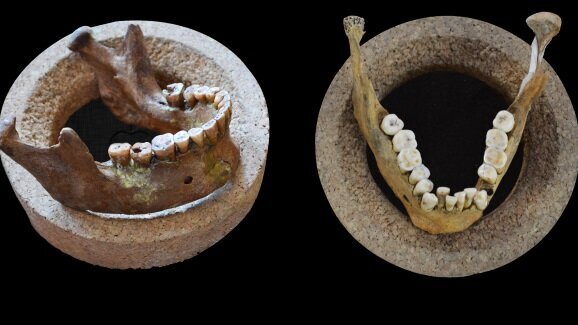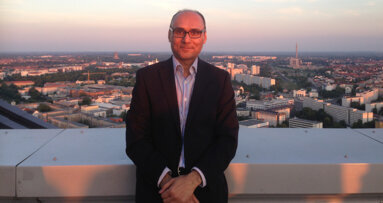DUBLIN, Ireland: Malocclusion and dental crowding appear to have spread concomitant with the prehistoric transition from hunting and gathering to agriculture. A new international study has found that both conditions first became common among the world’s earliest farmers 12,000 years ago in South-West Asia.
In the study, a team of international researchers analysed the mandibular and crown dimensions of 292 archaeological skeletons from the Levant, Anatolia and Europe from between 28,000 and 6,000 years ago. The results show a clear separation between European hunter-gatherers, Near Eastern/Anatolian semi-sedentary hunter-gatherers, and European farmers based on the form and structure of their jawbones.
“Our analysis shows that the lower jaws of the world’s earliest farmers in the Levant are not simply smaller versions of those of the predecessor hunter-gatherers, but that the lower jaw underwent a complex series of shape changes commensurate with the transition to agriculture,” said Prof. Ron Pinhasi from the School of Archaeology at University College Dublin and lead author.
With the shift to agriculture, solid foods like wild uncooked vegetables and meat were replaced with mainly soft cooked or processed foods like cereals and legumes. Soft cooked foods require less chewing, which in turn lessens the size of the jaws. Without a corresponding reduction in the dimensions of the teeth, this often results in malocclusion and dental crowding, since there is inadequate space in the jaw. The link between chewing, diet, and related dental wear patterns is well known in the scientific literature, and it has been suggested that malocclusion is associated with urbanisation. Previously, however, it was unclear as to whether its high prevalence began 8,000 years before with the beginning of sedentism and a change in nutrition.
While the hunter-gatherer populations show an almost perfect harmony between the lower jaw and teeth, this harmony is not an attribute of the earliest farmers. The correlation of inter-individual mandibular and dental distances found in the case of the hunter-gatherers was not evident in the semi-sedentary hunter-gatherers and farming groups. This suggests that the harmony between teeth and jawbone was disrupted with the shift towards agricultural practices and the resulting dietary changes among the different populations.
Today, malocclusion and dental crowding affect around one in five people in modern-world populations.
The study, titled “Incongruity between affinity patterns based on mandibular and lower dental dimensions following the transition to agriculture in the Near East, Anatolia and Europe”, was published online on 4 February in the PLOS ONE journal.
LONDON – A comparison of advice on toothbrushing for adults and children given by dental companies, textbooks and dental associations has found that ...
LONDON, UK: Though elite athletes generally possess an enviable level of physical fitness, a recent study has shown that their oral health may leave much to...
YORK, UK: Fear of the dentist is something some people suffer from more than others. With multiple reasons for dental anxiety and its effects, there is ...
LONDON, UK: Though the relative benefits of chewing gum are often subject to debate, a number of studies have shown that the sugar-free varieties can ...
LONDON, UK: All dentists know how important vitamin D is for healthy teeth and bones. In a new study, researchers from the University of Sheffield have ...
BRIGHTON, UK/ATLANTA, US: The incidence of thyroid cancer and meningioma is increasing globally. New research has found that repeated exposure to dental ...
NOTTINGHAM, UK: Given what we know about the relationship between rates of obesity and sugar consumption, it would seem to be common sense that children who...
LONDON, UK: According to 2017 statistics released by the NHS, there were more than 40,000 hospital operations to extract teeth in children and teenagers in ...
PORTSMOUTH, UK: Over the past decade, the British dental workforce has grown increasingly international. By 2016, for example, 35 per cent of newly ...
LONDON, UK: The COVID-19 pandemic has resulted in the widespread adoption of videoconferencing tools in many industries, and dentistry is no exception. A ...
Live webinar
Mon. 22 December 2025
6:00 pm UTC (London)
Live webinar
Mon. 12 January 2026
2:00 pm UTC (London)
Prof. Judith Jones D.D.S; M.P.H., Prof. Kakuhiro Fukai D.D.S., Ph.D, Dr. Bathsheba (Bethy) Turton
Live webinar
Wed. 14 January 2026
5:00 pm UTC (London)
Dr. Théo Laplane, Dr. Robert Gottlander DDS
Live webinar
Fri. 16 January 2026
5:00 pm UTC (London)
Live webinar
Mon. 19 January 2026
6:00 pm UTC (London)
Philipp Kopp, Michael Seeber
Live webinar
Thu. 22 January 2026
7:00 pm UTC (London)
Dr. Nicola M. Grande DDS, PhD
Live webinar
Wed. 28 January 2026
1:00 pm UTC (London)



 Austria / Österreich
Austria / Österreich
 Bosnia and Herzegovina / Босна и Херцеговина
Bosnia and Herzegovina / Босна и Херцеговина
 Bulgaria / България
Bulgaria / България
 Croatia / Hrvatska
Croatia / Hrvatska
 Czech Republic & Slovakia / Česká republika & Slovensko
Czech Republic & Slovakia / Česká republika & Slovensko
 France / France
France / France
 Germany / Deutschland
Germany / Deutschland
 Greece / ΕΛΛΑΔΑ
Greece / ΕΛΛΑΔΑ
 Hungary / Hungary
Hungary / Hungary
 Italy / Italia
Italy / Italia
 Netherlands / Nederland
Netherlands / Nederland
 Nordic / Nordic
Nordic / Nordic
 Poland / Polska
Poland / Polska
 Portugal / Portugal
Portugal / Portugal
 Romania & Moldova / România & Moldova
Romania & Moldova / România & Moldova
 Slovenia / Slovenija
Slovenia / Slovenija
 Serbia & Montenegro / Србија и Црна Гора
Serbia & Montenegro / Србија и Црна Гора
 Spain / España
Spain / España
 Switzerland / Schweiz
Switzerland / Schweiz
 Turkey / Türkiye
Turkey / Türkiye
 UK & Ireland / UK & Ireland
UK & Ireland / UK & Ireland
 International / International
International / International
 Brazil / Brasil
Brazil / Brasil
 Canada / Canada
Canada / Canada
 Latin America / Latinoamérica
Latin America / Latinoamérica
 USA / USA
USA / USA
 China / 中国
China / 中国
 India / भारत गणराज्य
India / भारत गणराज्य
 Pakistan / Pākistān
Pakistan / Pākistān
 Vietnam / Việt Nam
Vietnam / Việt Nam
 ASEAN / ASEAN
ASEAN / ASEAN
 Israel / מְדִינַת יִשְׂרָאֵל
Israel / מְדִינַת יִשְׂרָאֵל
 Algeria, Morocco & Tunisia / الجزائر والمغرب وتونس
Algeria, Morocco & Tunisia / الجزائر والمغرب وتونس
 Middle East / Middle East
Middle East / Middle East





















































To post a reply please login or register